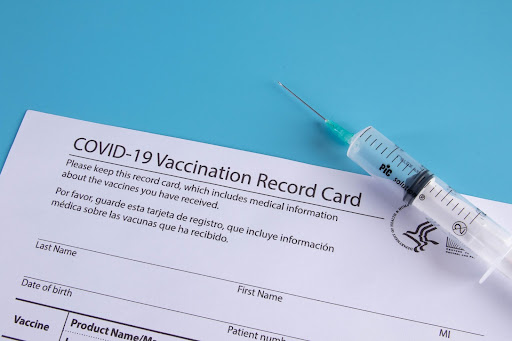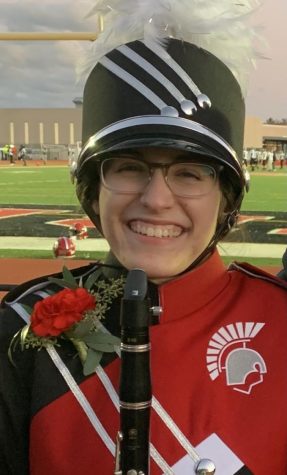A Shot Against Omicron: How the COVID-19 Vaccines Work

A syringe with a record card for COVID-19 vaccination. Image courtesy of https://www.flickr.com/photos/30478819@N08/51007959558
January 6, 2022
With the recent surge in cases due to the highly contagious Omicron variant, the race to vaccinate the population is more crucial than ever. In the past four weeks, the number of people vaccinated in Lake County has increased by over 3.7%, per the Lake County COVID Vaccine and Risk Tracker. According to Mark Pfister, the Executive Director of the Lake County Health Department, more than 15% of children from ages 5-11 have had at least their first dose as of November 15th, 2021. Since their authorization in late 2020, COVID-19 vaccines have been administered to over 80% of the eligible population in Lake County, and this count continues.
However, since the current COVID-19 vaccines work differently than the vaccines that most people are familiar with, they have often been clouded by misinformation. Although they have been widely distributed, there still remains confusion about several factors—namely their origin, their functionality, and what people can expect from them in the future—and thus a closer look at the available COVID-19 vaccines and questions surrounding them is needed.
Currently, there are two available varieties of the vaccine. The first type of COVID-19 vaccine is the messenger RNA (mRNA) vaccine, which requires two doses with timing variations depending on whether it is Pfizer-BioNTech or Moderna. For the Pfizer-BioNTech vaccine, doses are administered twenty-one days apart, whereas for the Moderna vaccine, doses are given twenty-eight days apart. Although they may seem like a new phenomenon, mRNA vaccines like the Pfizer-BioNTech and Moderna vaccines have their origins in the 1990s, and they have since been researched and documented. In the past, mRNA vaccines have been used to protect against infections from rabies, Zika, and influenza, among other viruses.
Inactivated vaccines and live-attenuated vaccines—which contain dead or weakened forms of pathogens, respectively—are more commonly known and used for diseases such as the flu, measles, and chickenpox. In contrast, mRNA vaccines do not contain samples of the virus in any form. Instead, they function by creating spike proteins on their surfaces, which then lock onto foreign entities such as coronaviruses. Once this target is created, the body will readily recognize the pathogen when it enters, destroying it with white blood cells. Also, contrary to what some may believe, the mRNA vaccine does not change a person’s genetic material. Dr. Sana Ahmed, a medical epidemiologist at the Lake County Health Department, detailed the process. “When the vaccine is put into a person’s body, the spike protein in its package enters the cell. It uses not the cell’s nucleus—where the DNA is stored—but the factory [mitochondria] in your cell, producing more of itself,” she explained. “After it spits it out, the rest of the vaccine disintegrates, and the body now is able to recognize the antibodies from the spiked protein and fulfill that immune response.” The Pfizer-BioNTech vaccine has been approved for adults, but it is notable for being the only one so far that has also been authorized for patients under the age of eighteen. The extraordinarily speedy development of the COVID-19 mRNA vaccine can be attributed to a number of factors. “The reason why the mRNA vaccines were created so quickly for COVID-19, or SARS-CoV-2, is because there was a lot of money that was put into the research and development and we also had the full genomic code,” said Mr. Pfister. In addition to these, each stage of the vaccine testing was conducted at the same time, which further explains its relatively fast approval by the Federal Department of Agriculture (FDA).
In contrast, the Johnson & Johnson vaccine is a viral vector vaccine. These viral vector vaccines were first created in the 1970s, and while they function differently than mRNA vaccines do, they ultimately fulfill the same purpose. Viral vector vaccines work by using a harmless virus, such as an altered adenovirus, as a means to enter the muscle cells of the patient. Then, they use the “cell factory” and mass-produce spike proteins on the cell, similar to the ones found on the surface of a coronavirus. In response, the body responds as it would to a normal pathogen, developing antibodies that are specific to the spike protein. If the body later encounters the actual COVID-19 virus, it will immediately react as it did to the modified cell, thereby eliminating it. For more information, watch the Mayo Clinic illustrate this process on their YouTube channel. The Johnson & Johnson vaccine has been used for adult patients since its authorization. However, unlike the aforementioned Pfizer vaccine, it has not yet been approved for use in people under the age of eighteen by the FDA. Also, it is distinct from the mRNA vaccines as it only requires one dose.
Additionally, vaccines need to be supplemented to provide the greatest protection to the general population. “No vaccine is 100% effective, but what [the COVID-19] vaccines have done for us is to prevent severe illness, hospitalization, and death from COVID-19… The majority of new cases today are happening in our five-to-ten [year old] group because they haven’t been able to get vaccinated,” Mr. Pfister stated. Although they prevent serious complications from infection, vaccines alone cannot completely stop the spread of COVID-19. Therefore, added measures are necessary to ensure the safety of students and staff. “[Mitigation protocols] are guidelines that have been established by the state and local health department are based on information that has been gathered by schools across the country,” Dr. Ahmed said. In order to determine which strategies work best, several studies have been conducted across the country. Dr. Ahmed described, “There are a number of studies now that have looked at the different mitigation protocols, and they’ve identified that layered mitigation—which includes masking in schools and school-sponsored activities, increasing ventilation, and physical distancing as much as possible—significantly lowers transmission in schools.”
This “Swiss-cheese strategy,” as Dr. Ahmed calls it, ensures the protection of staff and students more effectively than vaccines alone. Should one prophylactic procedure not account for everyone, then the next one acts as a fail-safe. By combining both thorough research and practice, schools have developed the current model for in-person learning, enabling them to continue operating. The emergence of the Omicron wave, which forced Deerfield High School to go remote on January 3rd, 2022, has threatened in-person learning in schools across the country. Thus, the need to closely follow these guidelines has become undoubtedly clear.
Coupled with social distancing and masking, vaccines are the greatest defense against cases and resulting complications. “[The COVID-19 vaccine] has been the most critical tool that we’ve had in our toolbox. Masks have been great, social distancing has been great, as well as washing hands, but ultimately it’s been the vaccines that has really improved our results,” Mr. Pfister elaborated. “In fact, [in 2021] we’re about four times less in our incidence rate than in 2020.” As their number of administrations continues to increase, vaccines are of the utmost importance, but additional preventative measures remain essential should the nation hope to see cases fall.

